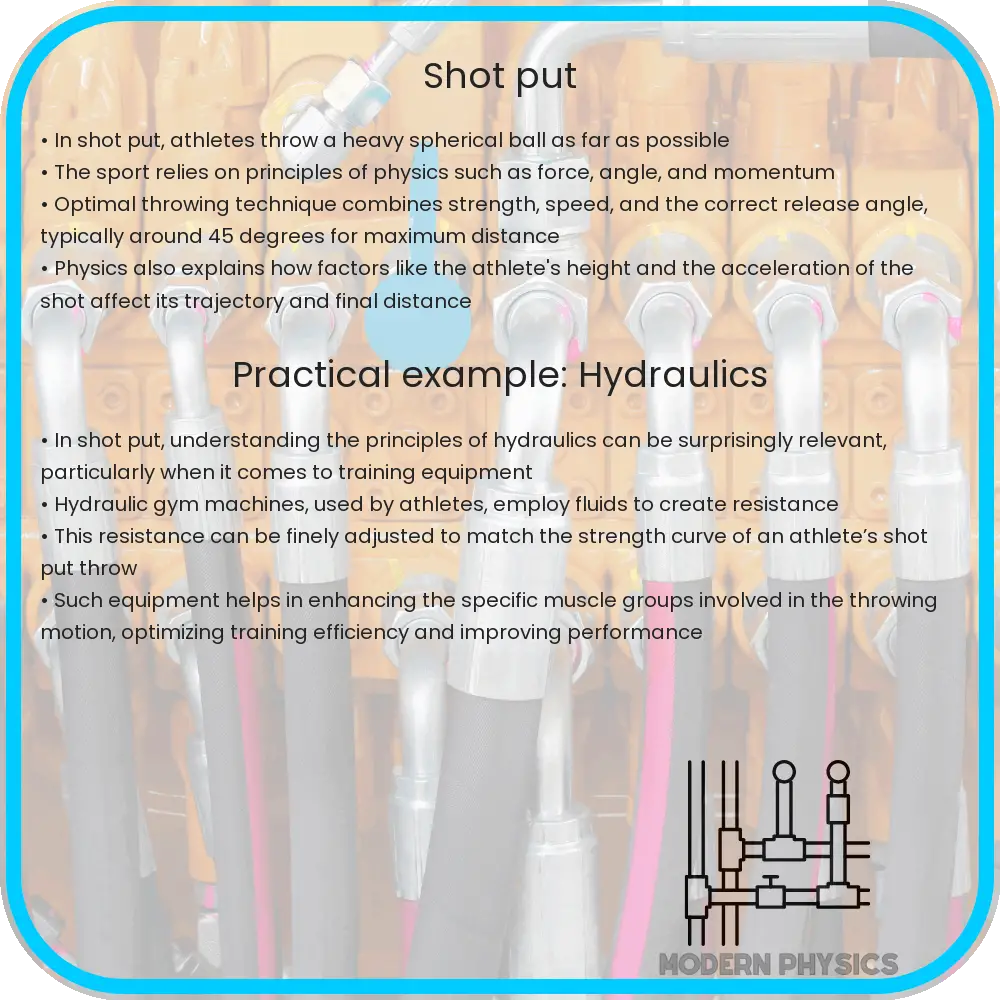Explore the science of shot put with insights on kinematics, power, angle, and technique, blending physics with athletic training for optimal throws.

Understanding the Kinematics of Shot Put
Shot put, an ancient track and field event, is a unique blend of power, technique, and kinematics. It involves throwing a heavy spherical object, known as the “shot,” as far as possible. The kinematics of shot put encompasses the motion, angle, and force involved in the throw.
Kinematics: The Foundation of Shot Put
Kinematics in shot put is primarily concerned with the motion of the shot without considering the forces which cause this motion. It includes understanding the velocity, acceleration, and trajectory of the shot.
- Velocity: The speed of the shot, combined with its direction of motion, plays a critical role in determining the distance it will cover.
- Acceleration: The rate at which the shot gains speed from the initial release to the point of leaving the athlete’s hand is a key factor in achieving maximum distance.
- Trajectory: The path taken by the shot, ideally, should be a parabolic curve. Achieving the optimal angle of release is crucial for maximizing the horizontal distance.
Power: The Driving Force
Power in shot put is a product of both speed and strength. It is the athlete’s ability to generate a burst of force in a short amount of time.
- Strength: The athlete’s muscle power, particularly in the legs, core, and arms, is fundamental to the initial propulsion of the shot.
- Speed: The rapid movement of the athlete, especially in the rotational or glide technique, contributes to the final velocity of the shot at release.
Optimal Angle of Release
The angle at which the shot is released plays a pivotal role in determining the distance of the throw. The ideal angle for shot put, taking air resistance and other factors into account, tends to be slightly lower than the theoretical optimal angle of 45 degrees.
For instance, an angle between 35 to 40 degrees is often considered optimal. This angle ensures that the shot gains enough height to maximize airtime while still maintaining a significant horizontal component in its trajectory.
In conclusion, mastering shot put requires a deep understanding of its kinematics, which involves the velocity, acceleration, and trajectory of the shot. Coupled with optimal power generation and the right angle of release, an athlete can achieve remarkable distances in their throws.
Integrating Technique with Physics
While understanding the physics of shot put is essential, integrating this knowledge with proper technique is what separates the best athletes. Technique in shot put can be broadly categorized into two styles: the glide and the spin.
- The Glide Technique: In this traditional style, the athlete starts at the back of the circle, facing away from the direction of the throw. A powerful leg push propels them forward, culminating in the shot’s release. This technique emphasizes linear momentum.
- The Spin Technique: Alternatively known as the rotational technique, this involves the athlete spinning on their axis in the circle to generate momentum. This technique capitalizes on angular momentum and is generally considered to generate more power.
Biomechanics and Training
Effective shot put training incorporates principles of biomechanics. Athletes must develop a regimen that enhances strength, flexibility, and technique. Key areas of focus include:
- Core Strength: A strong core stabilizes the body during the throw and is essential for transferring power efficiently.
- Leg Power: The legs generate the initial force required for the throw. Squats, lunges, and plyometric exercises are beneficial.
- Arm and Shoulder Strength: The final phase of the throw relies on the power in the athlete’s arm and shoulder. This requires targeted strength and flexibility training.
Conclusion: The Art and Science of Shot Put
Shot put is a complex sport that combines the art of technique with the science of kinematics and biomechanics. Understanding the principles of velocity, acceleration, and trajectory, along with the role of power and the optimal angle of release, sets the foundation for a successful throw. However, it is the integration of these scientific principles with the athlete’s technique, strength, and training regimen that truly makes the difference.
Whether an athlete chooses the glide or the spin technique, the key lies in harmonizing their physical capabilities with the physics of motion. Continuous training, focusing on core, leg, and arm strength, flexibility, and technique refinement, is essential. Ultimately, the mastery of shot put is a testament to the athlete’s dedication to understanding and applying these multifaceted principles in their quest for excellence.
